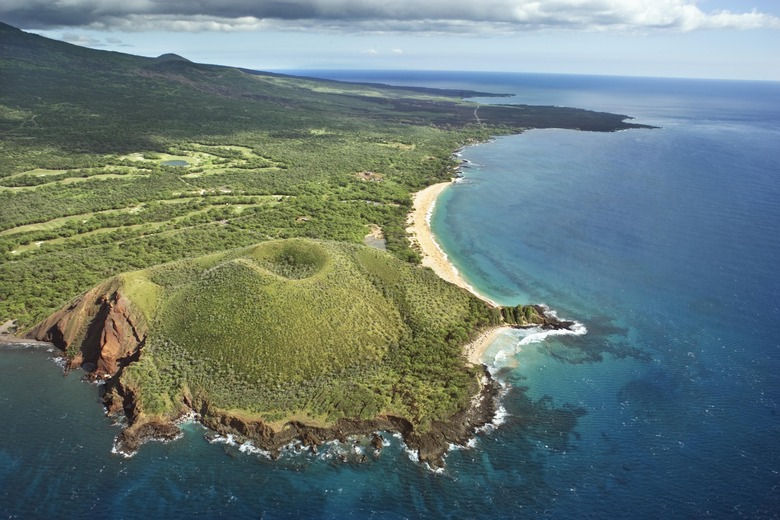How To Write A Report On Volcanoes
Geology reports don't have to lull readers to dreamland when you explain how a natural force can explode with more power than an atomic bomb, obliterate most of an island, change the weather and hurl shock waves around the globe. These are some of the incredible effects your report can describe when you discuss volcanoes — one of Earth's most powerful forces.
Why Volcanoes Exist
Why Volcanoes Exist
Pressure causes a multitude of physical actions to occur. Combine heat and pressure and you may create a volcano. Begin your report by explaining how magma — hot, liquid rock below the earth — rises because its density is less than the density of the surrounding rocks. The distance the magma moves vertically depends on factors such as the mass of the rocks it must go through and its density. Under intense pressure, dissolved gas in the magma helps propel it upward where it can make it to the surface and into the air depending on the volcano's type. Geologists call magma "lava" when it leaves a volcano via an eruption or vent.
Define a Volcano's Status
Define a Volcano's Status
According to the Global Volcanism Program, an extinct volcano is one people don't expect to erupt again, while an active volcano is one that has erupted in the last 10,000 years. Place these important facts into your report along with the definition of dormant: a volcano expected to erupt one day, but which hasn't in the last 10,000 years.
Not All Volcanoes Go "BOOM!"
Not All Volcanoes Go "BOOM!"
Talk about various types of volcanoes, such as Mt. St. Helens, a powerful stratovolcano that explodes with fury, hurling gas, rocks and ash high into the air. Shield volcanoes like Hawaii's Kilauea don't erupt as violently — they create rivers of lava that flow down the mountainside. Because the lava in shield volcanoes has low viscosity, they erupt less violently, creating gentle slopes around the mountain. Stratovolcanoes have high-viscosity lava, causing them to erupt more violently and form steep-sided slopes. Magma can also flow from fractures in a volcano without causing an explosive eruption — scientists call this a "curtain of fire."
Location, Location, Location
Location, Location, Location
You don't see too many volcanoes around the neighborhood because they only form in certain places — including under water. Submarine volcanoes sit an average of 2,600 meters (8,500 feet) below the oceans. According to some theories, over a million submarine volcanoes dot the ocean floor. The continents rest on tectonic plates in motion below the planet's surface. Explain how you find most volcanoes in places where these plates move away from one another at divergent plate boundaries, or towards one another at convergent plate boundaries. Hot spots, such as the one beneath Iceland, also create volcanoes. A hot spot is a location where magma has made its way through the Earth's crust.
How Volcanoes Affect the World
How Volcanoes Affect the World
Krakatoa erupted with fury in 1883, flinging ash up to 80 kilometers (49.7 miles) into the air, which lowered Earth's temperatures until 1888. The eruption also created a shock wave that circled the Earth seven times and triggered a massive tsunami that killed over 36,000 people. Lava flows are always a concern when volcanoes cause them near populated areas. Explain how lava usually moves too slowly to engulf people, but pyroclastic flows can travel down volcano slopes at up to 200 kilometers (124.3 feet) per hour. Composed of ash and hot gas, these flows kill anything in their path. On the positive side, tell your readers how volcanoes can create new islands, produce fertile soil, and produce pumice and other useful products.
References
- Cornell University Earth and Atmospheric Sciences: Discover Volcanoes
- Geology.com: Plate Tectonics and the Hawaiian Hot Spot
- Volcano – When a Mountain Explodes; Linda Barr
- Tulane University: Volcanoes and Volcanic Eruptions
- Oregon State University Volcano World: Historical Eruption Sounds
- Natural Disasters; Lee Davis
Cite This Article
MLA
Lee, Kevin. "How To Write A Report On Volcanoes" sciencing.com, https://www.sciencing.com/write-report-volcanoes-5565021/. 24 April 2017.
APA
Lee, Kevin. (2017, April 24). How To Write A Report On Volcanoes. sciencing.com. Retrieved from https://www.sciencing.com/write-report-volcanoes-5565021/
Chicago
Lee, Kevin. How To Write A Report On Volcanoes last modified March 24, 2022. https://www.sciencing.com/write-report-volcanoes-5565021/
